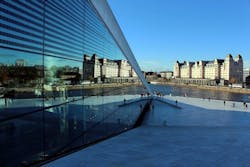Do car-free downtown zones work? Oslo, yes; Chicago, no
Two well-researched articles explore the question of whether keeping cars out of downtown is good or bad for business, for people's health, and for the environment.
Adele Peters, writing in Fast Company, has a positive answer to her own question: "What happened when Oslo decided to make its downtown basically car-free?" The Norwegian capital's city center has been made pretty much a no-no zone for cars. The city removed 700 parking spaces, and repaced them with bike lanes, mini-parks, and benches. Disabled drivers, emergency vehicles, and EVs still have access. Everyone else has to park in a reduced number of garages.
At the same time, the city beefed up public transit and made bicycling safer via a more-connected bike network. Its bike-share program reached 3 million trips in 2018.
Despite initial resistance from downtown businesses and car owners, says Peters, Oslo's city center has flourished. Oslo's vice mayor of urban development, Hanne Magnussen, said that some streets that were converted to pedestrian-only have become some of the most popular streets in the city.
STATE STREET, THE NOT-SO-GREAT STREET
Then there's what happened 20 years ago when Chicago decided to make State Street, its once great but quickly declining retail shopping nucleus, free of cars. As Mary Wisniewski, Transportation Reportwer for the Chicago Tribune, recently noted (in "Failure & bus fumes," October 27, 2019), the State Street Mall, originally billed as a car-free shopping paradise, started with high hopes. The city pumped $17 million into plantings, widening the sidewalks, and modernizing subway entrances, all in an effort to get pedestrians shopping, shopping, and shopping some more.
It didn't work. Wisniewski cites several reasons for the failure of the State Street Mall: "a racial subtext" (quoting a city planning historian: "Business owners felt that State Street was becoming too black"); fumes from buses ("It was like a big bus station," a biking enthusiast told her); even unfriendly light fixtures. The sidewalks were so wide - 40 feet - that most pedestrians never even came close to the shop windows along the street.
By 1993, City Hall had had enough. Then-mayor Richard M. Daley hired Skidmore, Owings & Merrill to lead a team on a $25 million restoration of State Street. Sidewalks were trimmed to a width of 22 feet. Previously closed street lanes were opened up. Cars were allowed back.
As a retail nexus, State Street has yielded primacy to Michigan Avenue, the Magnificent Mile. Maybe it was a natural, almost Darwinian, phenomenon: cities do evolve. But closing State Street to cars to create a suburban-type mall probably speeded up the process.
Do these street closings work? Wisniewski cites New York's closing of parts of Times Square as a success - that is, if you don't mind being assaulted by Disney figures and walking Statue of Liberty lookalikes trying to get you to pay for a photo op with them.
Your thoughts? I'd be glad to hear from you: [email protected].
About the Author

Rob Cassidy
Robert Cassidy is Executive Editor of Building Design+Construction and the Editor of Multifamily Design+Construction. A city planner, he is the author of several books, including “Livable Cities,” and was a co-founder of the Friends of the Chicago River.
